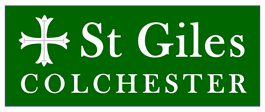Architecture
Like most mediaeval churches it is a mixture of architectural styles and one can still perceive in it features from 12th to the 20th centuries. The original construct was for a two aisled church with nave, chancel and gallery. The church of St. Giles comprises a chancel with north and south chapels, nave with south porch and west tower. The walls are of mixed rubble with some septaria and brick, the porch is mainly of brick, and the tower of wood. The roofs are of tiles, slates and lead. In the west end of the surviving south wall of the nave is a small lancet window, apparently of the 12th century. The chancel was rebuilt or at least remodelled in the 13th century when the surviving, blocked lancet window was made in the south wall. The north aisle of the nave and tower were probably built in the 14th century, and further work may have been done in 1423 when £3 15s. or more was spent on ironwork in the windows. The church was again remodelled in the early 16th century, when the south porch was added, a new east window inserted, and the north chapel built or completely rebuilt; the demolished north porch may have been the same date. The tower was repaired soon after 1514.

In 1748 only the chancel and a small part of the nave were used, the rest of the church lying in ruins, probably from the 1648 siege; there was a boarded Saxon west bell tower, perhaps that which existed in 1787, but that tower, which is constructed of reused materials, is central to the nave and aisle as they were amalgamated in 1819. Other work in 1819 included the bricking in of empty windows, and the insertion of wooden columns to support galleries and a low-pitched roof. Extensive alterations were made to the interior and furnishings in 1859. From 1886 funds were raised to restore the church or build a new one, but it was not until 1907 that the chancel and the north chapel were restored, and a vestry added south of the chancel, designed by Sir A. Blomfield.
The most recent remodelling of the church to its present day use has been skilfully constructed by Mr. F.S. Clater, a local architect, and the structural problems have been solved by making the converted building serve a dual purpose, though leaving the whole exterior unchanged. The ground floor, originally the nave and chancel with a side aisle and chapel, is now the dining area and bar. The upper floor, formerly the gallery is the Masonic temple, accessible via a modern spiral staircase in the bell tower.
When entering the building it is easy to believe that you are no longer in a former church. The South Porch, now unfortunately heavily affected by woodworm forms a fire escape from the temple. The other South entrances lead to the bar / toilets and kitchen area. The entrance by the West Tower, which probably made access to the Narthex is blocked (although the exterior door is still visible.) The Narthex now forms the “Blue” room, cloak room and toilets.
A large door on the North Wall probably gave access directly to the Nave. The Nave is now halved short of the edge of the gallery to form a bar area. The remainder of the Nave, North & South aisles form the dining area, to which the space in the North Chapel can be added for larger functions. The vestry / organ area form the kitchen. Only the dining area reveals the previously intended use and it is said that because the upper room area does not extend over the whole downstairs area the diners below have a very real sense of being in a mediaeval dining place when they take their seats at supper. The old East Window adds to that feeling.
